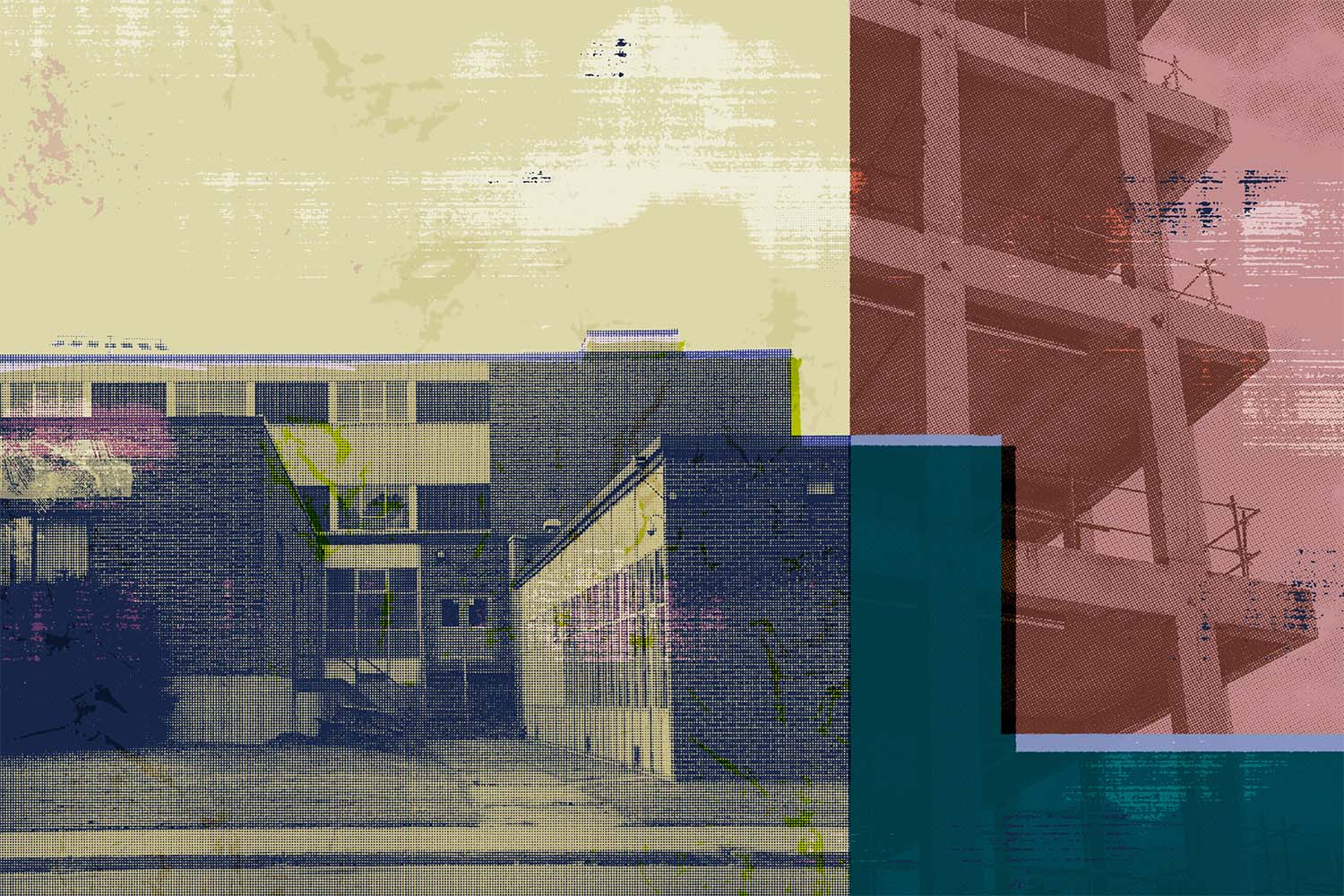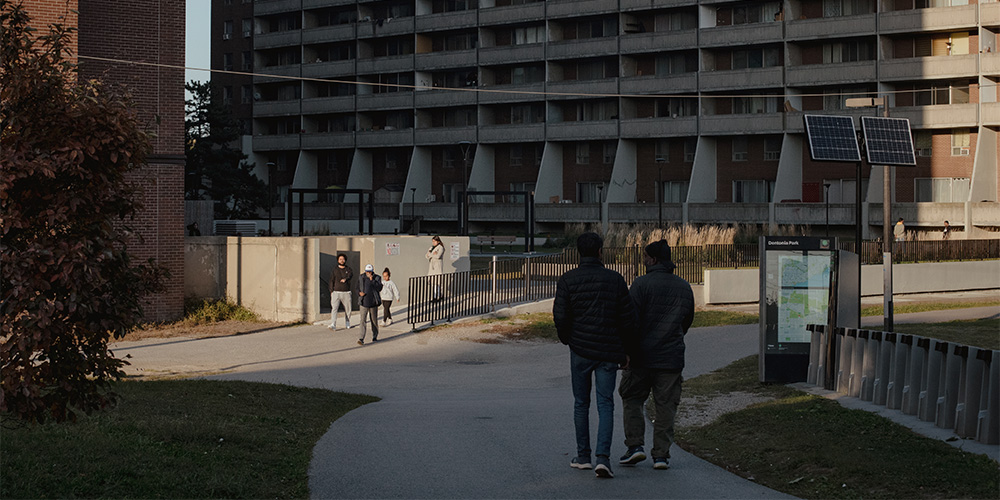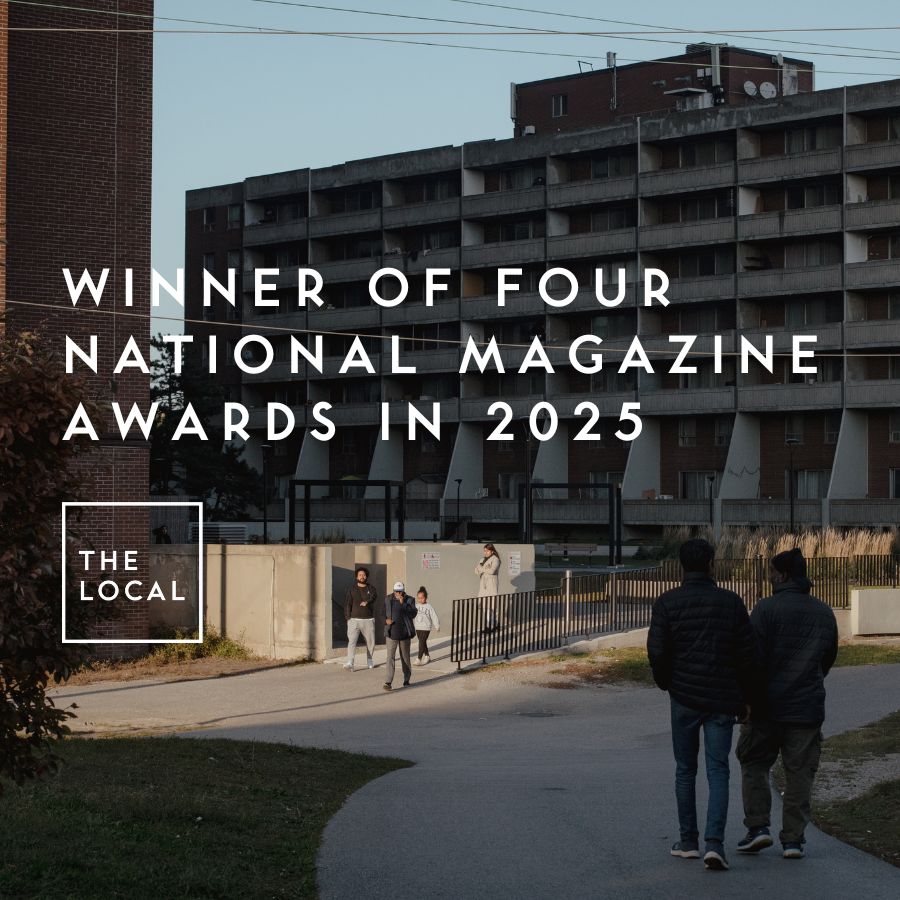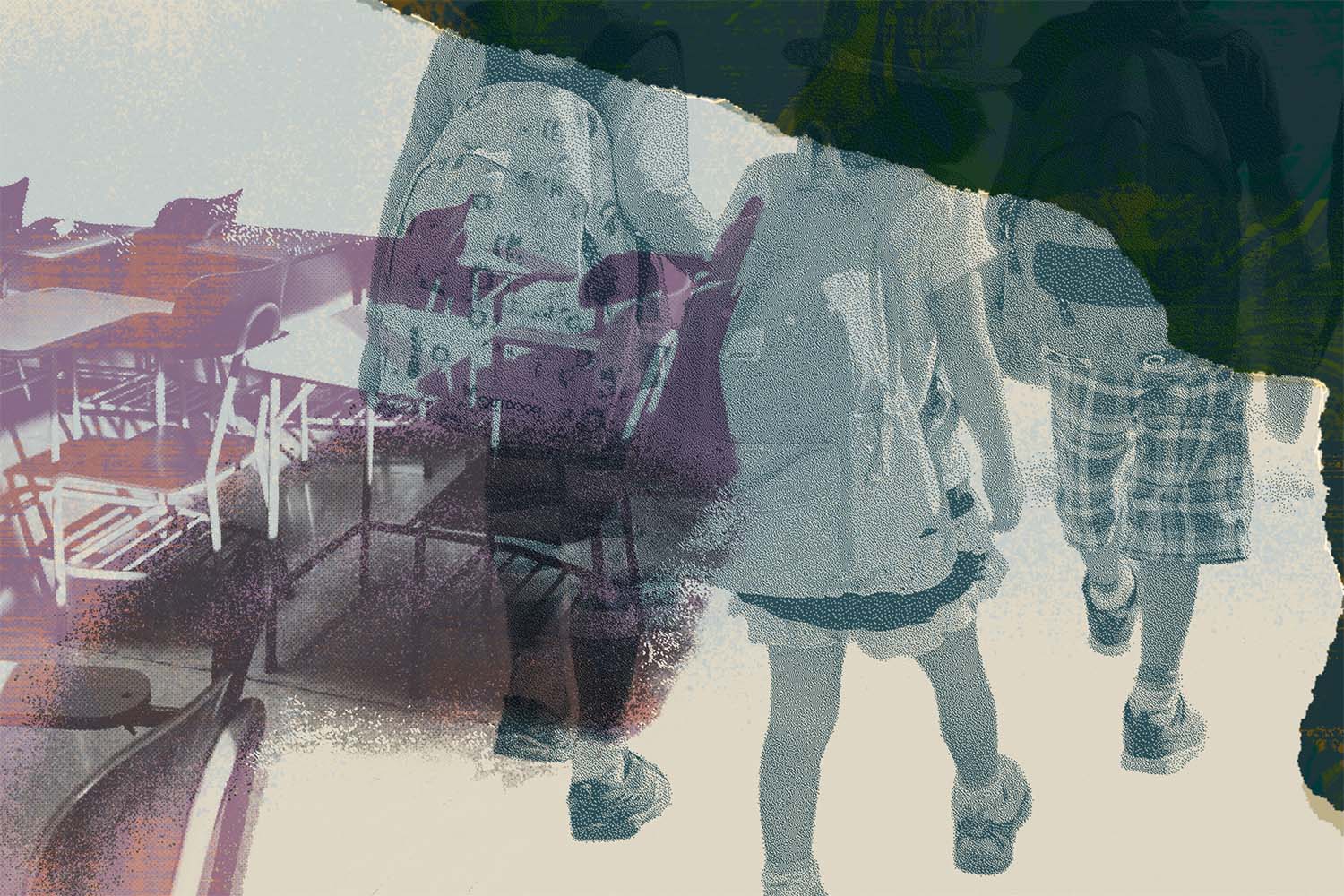

It’s currently an informal, dirt parking lot—there are no signs or pay stations and a piece of plywood covers a massive pothole. But the Toronto District School Board (TDSB) has big plans for this lot, nestled between the whoosh of the 401 and Bessarion subway station.
According to the TDSB’s plans, the JK-8 school planned for 50 Ethennonnhawahstihnen’ Lane in the Concord Park Place neighbourhood will be Toronto’s first new “urban format podium school” integrated into the first floors of a rental housing building. Those lucky enough to live in the building wouldn’t even have to go outside to get to class. The elementary school would cap off the walkable community that’s sprung up over the past two decades on land that was previously home to a Canadian Tire warehouse. The lot is within a 10-minute walk to a dozen highrises and right next to a gleaming new community centre that houses a daycare, light-filled library, a gym, and two pools.
But what’s happening now with this plan, and how or whether it’s progressing, is unknown. When the province took over the TDSB, it also took over the Toronto Lands Corporation (TLC)—the wholly-owned subsidiary of the board that manages $20 billion worth of land. The TLC’s CEO Ryan Glenn explained that all media requests must now be referred to the Ministry of Education. Meanwhile, the Ministry of Education media spokesperson hasn’t responded to any of The Local’s emails in relation to the school board takeover or the TLC’s operations. And the four TDSB trustees who previously sat on the TLC’s board (of 10 total) have been instructed to cease all work, according to one of those trustees who would only speak anonymously, fearing career repercussions of defying the ministry’s media clampdown. What this all means is that when it comes to the activities of the second-biggest public landowner in the city, both elected officials and the public are in the dark.
It’s not just this North York parking lot that could be affected by the provincial takeover of five school boards, including the TDSB, this year. It’s the fate of dozens of TDSB properties, which are currently vacant or home to non-operating schools. If the province were to amalgamate and close schools—which Education Minister Paul Calandra didn’t rule out in a recent interview with CBC’s Metro Morning—hundreds of public lands could be up for redevelopment. (In this city, the Toronto Catholic District School Board’s properties could also be affected by the takeover, but as it has much smaller net worth land holdings and its land development plans are not as ambitious as the TDSB’s, nor as documented, The Local is focusing on the TDSB’s lands.)
Opposition critics worry the takeover was at least partly about land. In an online public meeting in the spring, Peter Tabuns, MPP for Toronto–Danforth, questioned whether Premier Doug Ford was imposing a takeover in order to “control the sale of real property owned by the TDSB for the benefit of his developer friends, the way he did with the Greenbelt.”
Jessica Bell, MPP for University–Rosedale, said in a virtual town hall in July that she feared the province would “close [schools] with little supervision, and then sell off that land to the highest bidder, or, maybe I’m being cynical here, the developer that has contributed to the PC party’s re-election campaigns.”
To understand what’s at stake, it helps to understand what the TLC does, or at least what it did before the takeover. While the TLC website is still up, there hasn’t been a news update since June (before that, there were several posted a month), nor have any of the usual meeting updates or minutes been published online. TLC CEO Ryan Glenn is still, however, responding to his TLC email, even if only to say he can’t speak to media.
Join the thousands of Torontonians who've signed up for our free newsletter and get award-winning local journalism delivered to your inbox.
"*" indicates required fields

The TLC was incorporated in April 2008, a decade after the amalgamation of six local school boards–Toronto, North York, Scarborough, Etobicoke, York, and East York. The cost-cutting maneuver meant that the TDSB was suddenly one of the largest landowners in the city. Today, the TDSB’s lands are valued at more than $20 billion. To put that in perspective, the City of Toronto’s real estate portfolio is valued at $27 billion; the Vancouver School Board’s properties are worth about $9.5 billion.
While all school boards engage in the buying, leasing, development, and selling of property, the TDSB is the only school board in the country that has created its own real estate company. The subsidiary is meant to allow board administrators and trustees to focus primarily on education with the peace of mind that experts in real estate and land use planning are, ideally, expertly managing the TDSB’s land assets. To ensure accountability, TDSB trustees and staff held a majority of seats on the board before the provincial takeover.
In addition to the sheer size of the real estate portfolio, the TLC exists because building and maintaining public schools in a city like Toronto is complicated. In many Toronto neighbourhoods, it’s cost-prohibitive to purchase a plot big enough for a school. “Building a two- or a three-storey school with a parking lot and a playground or sports field next to it, there’s no land in the borders of the City of Toronto to do that anymore,” explains Mark Richardson, technical lead of HousingNowTO, a volunteer-led organization that monitors progress on the city’s affordable housing projects. (With his interest in livable, affordable communities, Richardson is also a close watcher of what the TLC does with its lands.) Increasingly, new schools in Toronto only get built in agreements with the City or with private developers.
For example, the new Davisville Public School in midtown Toronto, which opened in 2021, was funded through a unique partnership with the province, the City of Toronto, and the TDSB. The TLC negotiated a long-term lease and shared-use agreement with the City, allowing the City to build a community aquatic centre on part of the land. Students will get to use the two new pools (expected to be completed in 2027) for four hours each school day, while the City can access the school’s new gymnasium for evening and weekend recreational programming. Thanks to the agreement, the TDSB got to trade up a building that was leaky with narrow corridors and dark classrooms, for a modern school with big windows, soaring ceilings, and rooftop terraces. (The demolition didn’t make everyone happy—the building’s “1960s optimist” exterior was treasured by many architecture aficionados.)
Another example is the planned Sugar Wharf Public School, a JK-8 school slated for construction across the street from the Redpath Sugar refinery. Rather than buying land, the TLC worked out a financial agreement with developer Menkes to construct a school on the third floor of a condo building. The 455 students the school is expected to enrol would get access to a third-floor outdoor rooftop playground as well as shared access to a playground at a nearby City-owned park.
Adding to the complexities of managing TDSB real estate is that demographics in the city of Toronto are very much in flux. Consider Concord Park Place, Liberty Village, the Distillery District, or CityPlace—former industrial or Crown lands that went from housing no one to housing thousands of people each (20,000-plus in the case of CityPlace) within a couple of decades. “There’s been a huge shift in Toronto’s population over the last 20 years with lots of families with children in condos downtown, and no school anywhere near them because it used to be in the middle of an industrial area,” explains Hugh Mackenzie, an economist and a long-time researcher on public education in Ontario.
As it partners with other organizations and companies, the TLC can think not just about school building, but also city building. According to the TLC website, one of its key purposes is to “build communities where people live, learn, work and play.” The TLC’s 2025 to 2026 Annual Plan talks about better integrating schools with housing and community services, considering active transportation in planning, and even combining a new school with a long-term care facility to allow for intergenerational programming.
In May of this year, city council directed the City to enter into a memorandum of understanding (MOU) with the TLC to “develop mutually beneficial building solutions” across an initial list of eight TDSB properties. According to a TLC update posted shortly before the board takeover, the agreement could create 10,000 new rental homes, including approximately 2,100 affordable units. Before the takeover, Glenn hinted in the media that the eight initial properties could just be the beginning. (The Ethennonnhawahstihnen’ site is part of the MOU). When asked whether the MOU was going forward while the TDSB is under provincial supervision, Alexandra Dinsmore, a communications advisor at the City of Toronto, sent a statement that said the City and TLC “continue to work together to advance the initiative.” The statement included the line, “for more information, please reach out to TLC directly.”
Colleen Bailey, a volunteer with More Neighbours Toronto and research associate at Sunnybrook Health Sciences Centre, fully supports the TLC’s plan to partner with the City to build both affordable housing and schools. She points out that renters in the city often only have two choices: an old purpose-built rental building with heating/cooling and pest issues, or a unit in a new condo building that carries the threat of eviction or price hikes at the whim of the owner.
Currently, many kids living in buildings either don’t have a school that’s close to them or they “get bussed to undersubscribed schools in nearby neighbourhoods” because their building isn’t zoned for the local school, Bailey explains. That’s because the walkable school is too full, and the easiest solution for the TDSB is to assign whole buildings to a school that’s further away. Planning and building family-sized rental houses in tandem could facilitate walkable schooling for kids growing up in highrises, she explains.
From rental housing to schools co-designed with long-term care homes and community hubs, “the province hates what the Toronto Lands Corporations does,” according to Mackenzie. Why? “Because it’s a symbol of the school board doing things that don’t have anything to do with reading, writing, and arithmetic.” The TLC is involved in housing and long-term care projects that the province could itself lead, with all the requisite good PR and in line with its own strategy. Mackenzie points out that the Conservative party’s strategy is likely to be much more market-driven than the TLC’s. The trustee who sat on the TLC’s board before the province asked trustees to cease all TDSB-related work called the provincial takeover “extremely disappointing, given a lot of the community-building work the TLC was doing was just getting started.”
Let's Dig Even Deeper
Help us raise $10,000 to investigate Doug Ford's takeover of Toronto-area school boards. Your donation will be matched dollar for dollar by an anonymous donor.
SupportWe don’t know that it’s true that the province doesn’t like the TLC’s expansive mandate—given the aforementioned lack of response from the Ministry of Education to our questions—but there are signs the province would like to have more say in what happens with TDSB lands.
In 2023, the TDSB put its wholly-owned subsidiary on a shorter leash—restructuring its board to give majority control to TDSB representatives and replacing the TLC’s CEO—in large part, because TLC representatives had met with Ford government officials without their approval. This points to the province’s interest in the TLC’s work, as well as the TDSB’s deep distrust of the Ford government’s intentions.
Last spring, Stephen Lecce, Ford’s then Minister of Education, said the province wouldn’t give the TDSB permission to combine schools as a cost-cutting measure, explaining that the TDSB is “sitting on the largest real estate portfolio in the city of Toronto” and therefore should be able to balance its budget. (As mentioned, it’s actually the second-largest publicly owned real estate portfolio in the city). His comment seems oblivious to the reality that the TDSB isn’t allowed to use proceeds from the sale or lease of lands to fund educational programming—legislation stipulates that Ontario school boards can only use that money to maintain existing buildings. But the point seems to be that the government would prefer that the TDSB not sit on its assets. Indeed, in June, the government approved regulation that allows it to direct school boards to sell certain surplus properties. In his interview with the CBC earlier this month, Calandra said the province has its sights on “real estate that has been surplus, but not utilized, in some cases, well over 10 years.”
It’s arguable that the provincial government’s push for school boards to sell land could be beneficial for our public schools. A December 2024 report from the Financial Accountability Office found that it would take $6.5 billion to bring existing schools in Ontario to a state of good repair. The TDSB repair backlog alone was estimated at $2.9 billion. Hypothetically, supposing that the TDSB’s 30-plus shuttered schools or vacant lands are worth $25 million each, selling those properties would cover about a quarter of Toronto’s repair backlog.
But advocates say that would be short-sighted. Toronto is growing, and the TLC is already planning new schools on several of its properties. Plus, it’s leasing buildings to make money in the meantime. Even if the TLC doesn’t currently have plans for specific lands, given Toronto’s rapidly changing demographics and penchant for erecting whole new neighbourhoods on former industrial lands, it could find itself desperately in need of land in the future, say in 10 years. As MPP Bell explained in the virtual town hall meeting, “Once that land is gone, we never get it back, and if we do try and get it back, it’s going to be prohibitively expensive.”
Even if its lands are not ideally located, the board could use them to propose land swaps. For example, in 2019, the TDSB transferred land hosting an empty former high school in Scarborough to the City in exchange for a swath of land in an area undergoing rapid development that’s a stone’s throw from the Eglinton LRT and Ontario Line (near the closed-down Ontario Science Centre). That area is soon to be in desperate need for a new school.
The TDSB also has an incentive not to sell, because its lands can be used as “bargaining chips” with the provincial government, Mackenzie explains. If the TLC has plans to build a new school, it needs provincial approval and funding. In discussions with the province, the TDSB can sweeten the deal by offering to sell a parcel of land to partially or wholly fund the project. Bloor Collegiate, a $56-million high school that just opened earlier this month—with bright, open common spaces, a culinary arts classroom, a dance theatre, and a robotics lab—was financed by a land sale, with the Liberal provincial government at the time chipping in $20 million.
Opposition critics and education and housing advocates don’t simply worry about the sale of TDSB lands. Given the province’s scandal-plagued Therme spa deal and Greenbelt fiasco, they question who the buyers will be, and who will ultimately benefit. Ontario legislation stipulates that any school board land must first be offered to public-benefit organizations like another school board, a non-profit organization, or the City. (Public-benefit organizations have 90 days to express interest and the selling price must be “fair market value,” determined by an independent appraiser.) In recent years, the City or the Toronto Catholic District School Board have bought up the few TDSB properties put on the market. Artscape Youngplace, a cultural hub in West Queen West with accessible studios and free public art galleries, is housed in a former public school that the TDSB sold to the City. But an en masse sell-off could mean not enough public buyers for available lands. Plus, the province could change its legislation.
The TLC’s management of TDSB lands isn’t a study in efficiency. Many TDSB schools are in shocking disrepair—the tiles in the hallway of my daughters’ midtown elementary school curl up at the sides and form noticeable ridges, and the basement drips. Perhaps the TDSB should consolidate more of its administrative buildings and sell some of its 30-plus vacant or leased lands to fund repairs.
Still, the TLC’s mission to ensure maximum public benefit from its lands is laudable. It holds community consultations, and, up until the takeover, TLC representatives were open with the media about the status of school redevelopments and their future plans.
What’s most frightening about the provincial takeover of the TDSB, when it comes to public lands worth $20 billion, is the province’s silence. We don’t know whether the TLC will be able to advance its plans to build modern schools, increase rental housing, and facilitate walkable communities with recreational amenities shared by students and community members.
Mark Richardson of HousingNowTO points out that the Sugar Wharf school has been massively delayed due to condo market realities, and interested parties have no one they can turn to for accountability. “Normally, we’d be able to go to the Toronto Lands Corporation and say, ‘What’s the status on this school?’” he explains. “Now, it’s totally opaque to us.”
Correction—Sept. 23, 2025: a previous version of this article incorrectly stated that the TLC was incorporated four months after the amalgamation of six local school boards.
Clarification—Sept. 23, 2025: This story has been updated to reflect that the government approved legislation allowing it to direct school boards to sell certain surplus properties.





